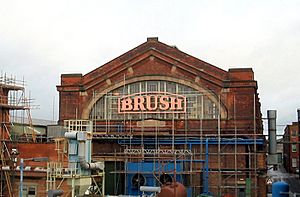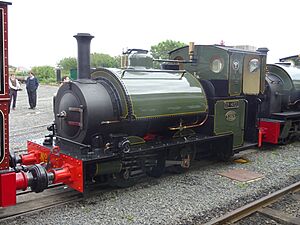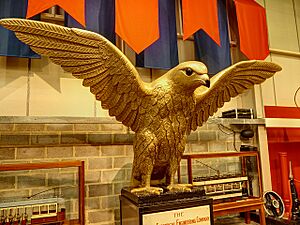Brush Traction facts for kids
| Founded | 1865 |
|---|---|
| Headquarters |
,
England
|
| Parent | Wabtec |
Brush Traction was a famous company in Loughborough, England. They used to build and fix train engines. Now, their work is part of a bigger company called Wabtec.
Contents
The Story of Brush Traction
Starting with Henry Hughes
Henry Hughes started his business, Falcon Works, in the 1850s. He made metal parts for engines and farm machines. In 1860, he teamed up with William March. Their company, Hughes and March, also built "railway plant," which means railway equipment.
By 1863, Hughes was making small steam locomotives. These were designed for building sites and mining railways. They were 0-4-0ST engines, meaning they had four driving wheels and a saddle tank for water.
In 1877, Henry Hughes formed a new company called Hughes' Locomotive & Tramway Engine Works Ltd. This company continued to make small locomotives. They also started building tram engines. These were light steam engines that pulled passenger cars on tram lines.
Some early engines included The Pioneer for the Swansea and Mumbles Railway in 1877. They also built engines for the Snailbeach District Railways and the Corris Railway. In 1881, Hughes' built two engines for the Liverpool Corporation Waterworks to help build a waterworks in Wales.
Steam trams were not very popular in the UK. However, the company sold some abroad, like in Paris. The company faced financial problems and closed down in 1881. Henry Hughes then moved to New Zealand.
The Falcon Engine & Car Works
The old company was sold and became the Falcon Engine and Car Works Ltd. in 1882. They continued to make locomotives, carriages, and tramcars. This included more engines for the Vyrnwy railways. In 1883, they built a horse-drawn tramcar for the Alford and Sutton Tramway.
They even built special carriages for the Listowel to Ballybunion monorail in 1888. This was a unique railway where trains ran on a single rail. They also made tank locomotives for places like Ireland, Spain, and the Azores.
Brush Electrical Engineering Company
In 1889, a company called Anglo-American Brush Electric Light Corporation Ltd. took over the Falcon Works. The new company was named the Brush Electrical Engineering Company Ltd.
In the 1890s, Brush mainly focused on lighting for towns and ships. But they also worked on rail and tramcars. They believed electric trams would become very popular. By 1897, they expanded their factory to build 250 more tramcars each year. In 1898, they could make 1,000 electric motors annually.
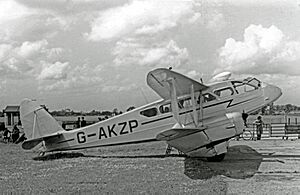
Brush also made some early motorcars starting in 1902. They built nearly 100 buses and some lorries until 1907. They also built carriages for London's underground railways, like the Central and Northern lines, in the early 1900s.
Brush built about 250 steam locomotives in total. After World War I, they stopped making steam engines. They focused on electrical equipment for transport, such as tramcars, trolleybuses, and battery-powered vehicles.
During World War II, Brush Coachworks helped build aircraft. They made 335 de Havilland Dominies for the Royal Air Force and Fleet Air Arm. They also built parts for Lancaster bombers.
After the war, the coachworks continued to build bodies for buses. In 1952, the coachworks closed. Another company, Willowbrook, bought their designs.
Brush Bagnall Traction
Brush kept its connections with the railway industry. In 1947, another company, Heenan & Froude, bought Brush. Brush then joined with W. G. Bagnall to make diesel locomotives. In 1951, they formed a new company called Brush Bagnall Traction Limited. When British Railways started replacing its steam engines, Brush began making main line diesel-electric locomotives.
Brush Traction Today
In 1957, Hawker Siddeley bought the Brush group. Later, it became part of BTR plc and then Brush Traction. In 2008, it was bought by Melrose Industries.
In 2007, Brush Traction bought Hunslet-Barclay, a company in Kilmarnock. It was renamed Brush-Barclay.
In February 2011, Wabtec bought Brush Traction. The Loughborough factory continued to build and repair locomotives. However, in April 2021, Wabtec announced that the Loughborough factory would close. This was because there wasn't enough work to keep the site running.
Locomotives Built by Brush
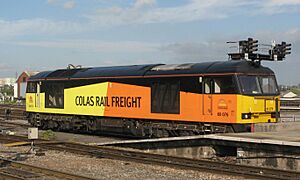
Brush made many different diesel and electric locomotives for the British railway network:
- Class 31 "Brush Type 2" diesel locomotive
- Class 47 "Brush Type 4" diesel locomotive
- Class 48 "Brush Type 4" diesel locomotive
- Class 53 Falcon prototype diesel locomotive
- HS4000 Kestrel
- Class 57 diesel locomotive (rebuilt from Class 47)
- Class 60 heavy freight diesel locomotive
- Class 92 electric locomotive
They also built the Eurotunnel Class 9 electric locomotives. These trains are used by Eurotunnel to travel through the Channel Tunnel.
Brush Traction also built locomotives for other countries:
- Diesel-electric locomotives for Ceylon (now Sri Lanka) in 1952 (Sri Lanka Railways M1)
- More diesel-electric locomotives for Sri Lanka in 1981 (the M7 class)
- Diesel-electric locomotives for Rhodesia (now Zimbabwe) in 1963
- Various diesel electric freight locomotives for Cuba, Tanzania, Gabon, and Morocco
- Battery electric locomotives for Hong Kong
- EF class heavy freight electric locomotives for New Zealand
- Class 18 shunter locomotives for Malayan Railways in 1978
Brush was also a big supplier of equipment for rapid transit systems. This included London Underground and Docklands Light Railway in the UK. They also supplied equipment to Canada and Taiwan.
They provided equipment for various Electric Multiple Unit trains in Britain. They also supplied parts for the Class 43 HST diesel locomotive. Between 2005 and 2010, Brush replaced the engines in most Class 43 HST power cars with new MTU engines.
Surviving Steam Locomotives
Several steam locomotives built by Hughes or Falcon Works are still around today:
- No. 3 ‘Sir Haydn’ was built for the Corris Railway. It now runs on the nearby Talyllyn Railway.
- A standard gauge 0-4-0ST built by Brush Electrical Engineering is preserved at Mountsorrel & Rothley Community Heritage Centre.
- A broad gauge saddle tank locomotive built at the Falcon Works is preserved in the Azores.
- Two narrow-gauge Falcon locomotives (Nos. 265 and 266) from the Beria Railway are in the Vale of Rheidol Railway Museum Collection.
- Several metre gauge Falcon locomotives are preserved in Spain, including Ex. F.C. Reus - Salou No. 3, No.6, and No.5 'SALOU'.
- Elfkarleö Bruk No. 1, built in 1873 by Henry Hughes & Co., is now in a museum.
Surviving Diesel Locomotives
More than 75 diesel engines built by Brush Traction have been saved. You can see them at heritage railways across the United Kingdom. Many more are still used on the main railway lines today.
Preserved Trams and Light Rail Vehicles
Many trams built by Brush are preserved, especially in Auckland, New Zealand:
- Auckland Electric Tramways Company, No. 11 (1902) – a double-bogie tram. It has been restored.
- Auckland Electric Tramways Company, No. 17 (1902) – a double-decker tram.
- Auckland Electric Tramways Company, No. 24 / No. 26 (1902) – parts of these trams are preserved.
- Auckland Electric Tramways Company, No. 44 (1906) – a restored tram body.
- Other Auckland trams (89, 91, 147, 203) originally used Brush parts.
- In 2012, old Brush tram parts were found during an excavation in Auckland. These parts are now at the Museum of Transport and Technology (MOTAT) for research.
- A Brush four-wheel truck from the Napier Tramways is also preserved.
In the United Kingdom, several Brush trams are preserved:
- Chesterfield No. 7 (1904) – preserved at the National Tramway Museum in Derbyshire. It was used as a holiday cottage for many years before being restored.
- Derby Corporation Tramways No. 1 (1904) – also at the National Tramway Museum.
- Several Blackpool Tramways trams (No. 298/635, No. 630, No. 623, No. 631, No. 626, No. 634) are preserved. Some are operational, while others are being restored.
- Blackpool Tramways No. 762 (1982) – preserved at the National Tramway Museum.
- Hythe Pier, Railway and Ferry engine numbers 16302 & 16307. These two locomotives from 1917 were originally battery-electric vehicles. They now run on the Hythe Pier Railway.
On the Manx Electric Railway on the Isle of Man, several vehicles use Brush D trucks, even if their bodies were built by other companies.
Battery-Electric Vehicles
In 1940, Brush needed small battery-electric tractors. Since none were available, they asked AC Morrison to design one. Brush then started making these 3-wheeled tractors for their own use. They later sold them to others, including a large order to Russia in 1941.
After 1945, Brush began selling battery-electric road vehicles. They bought the designs from Metropolitan-Vickers. Their 3-wheeled vehicles were called the Brush Pony. They also made 4-wheeled vehicles. In 1948, they added a 2-ton chassis that could be a van, flat truck, or milk float.
In 1949, Brush lowered the prices of their electric vehicles to compete with petrol vehicles. They offered 25 different body types for their chassis. Production of 4-wheeled battery electrics stopped in 1950. However, they continued to make the 3-wheeled Brush Pony milk float and industrial trucks.
In 1972, Hawker Siddeley bought a share in Crompton Leyland Electricars Ltd. To make things more efficient, Brush's industrial truck production moved to the Morrison-Electricar factory. This included the Brush Pony milk float.
Preserved Battery-Electric Vehicles
- An early Brush Pony 3-wheeled milk float from 1947 is at the National Motor Museum, Beaulieu.
- A Brush 10/14 cwt Mark II bread van from 1947 is at The Transport Museum, Wythall.
- The Ipswich Transport Museum has a Brush Pony electric laundry van from 1967.
- The National Transport Museum of Ireland has a Brush 2-ton electric lorry from 1947. It was used by a laundry company in Dublin until 1981.
Preserved Aircraft
A de Havilland Dominie DH.89 aircraft that Brush built in 1946 for the RAF is preserved at the Tangmere Military Aviation Museum.
Other Relics
A large statue of a falcon from Brush's Loughborough factory is now on display at the National Tramway Museum in Crich, Derbyshire.
See also
- Associated British Oil Engine Company
- Brush-Barclay
- Brush Transformers


